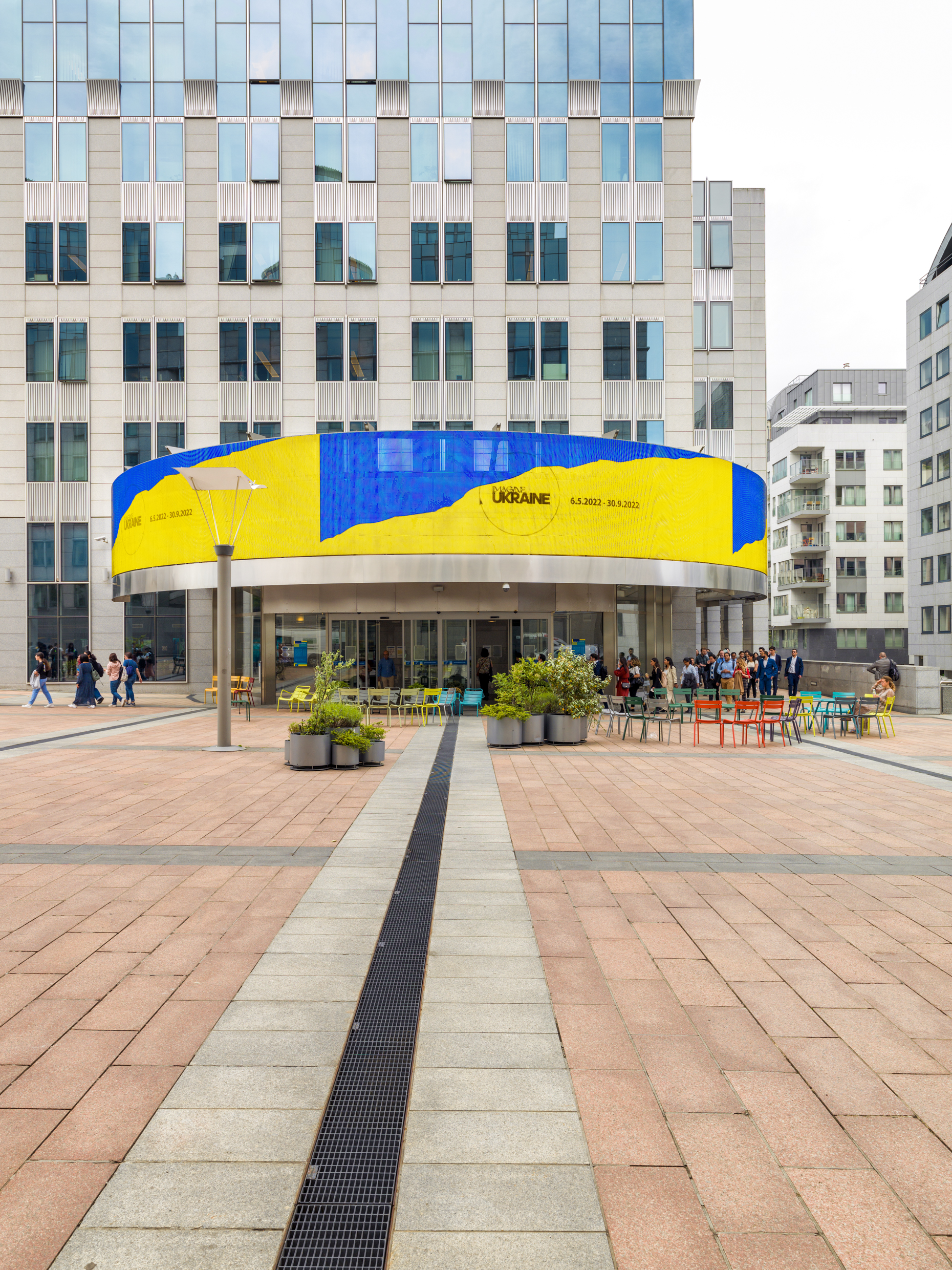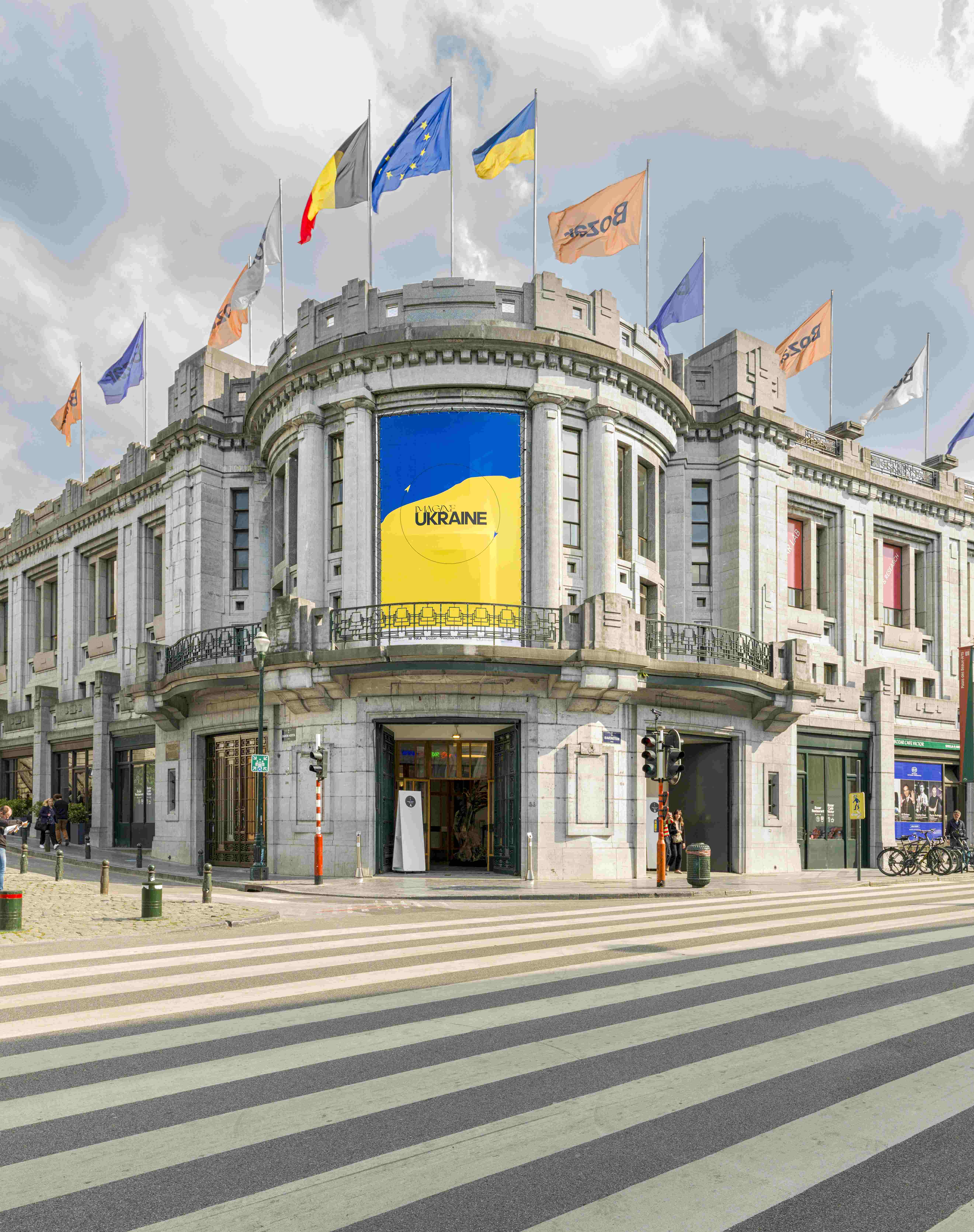IMAGINE UKRAINE - Exhibitions
Imagine Ukraine is an ambitious project that aims to reach out beyond the immediate urgencies, however pressing those continue to be. It wants to open up to the larger reflection and longer term perspective that are needed for the future. Europe needs an enhanced focus on Ukraine, its concreteness and complexity, its possibilities and flight lines. Our joint understanding needs to grow.
To start with it consists of three exhibitions, curated by Bart De Baere and Björn Geldof, based upon the works of Ukrainian artists in the collection of the Flemish Community, presented at Bozar, the European Parliament and M HKA.
These are the starting points to initiate a reflective space about the past, present and future of the Ukrainian part of Europe. In the European Parliament the perspective will be the artist as a witness, in BOZAR the tension between big narratives and the reality of human lives, in M HKA art as a critical capacity.
(c)Photos: Pat Verbruggen, 2022
Worth Fighting For

14.11 - 14.12.2022
Oskar-Jäger-Strasse 97-99, 50933 Cologne
Open every day, 10:00 – 18:00
The Ukrainian fight is about the survival of a nation and its right to exist – politically, militarily, economically, and culturally. When the Russian invasion started, Western Europe responded with an amazing wave of support for its neighbouring country, justly considering it part of the European community, yet to this day, Ukraine as a culture remains barely known to many European citizens.
After the invasion had been launched, the PinchukArtCentre, the leading Ukrainian contemporary Art museum, teamed up with the Antwerp contemporary art museum M HKA to address not only immediate urgencies but also strategic challenges.
This war is not the end, not even a means to an end. The resistance and assistance are propelled by what may come after. On the most basic level, this implies that Ukraine and Western Europe get more acquainted, and in a second step, that their capacities start to enhance one another. Finally, it may also be about a joint understanding, joint imagination, and values. The horizon – just as the war and the aid – is therefore essentially a cultural one.
Art may offer a vital space of reflection for this, for Europe to better understand the vital and vibrant Ukrainian art scene as part of an international ecology, but also for Ukraine to keep seeing itself as part of a wider world. When re-opening the PinchukArtCentre in June this year, the partnership came to address a country at war; much more than a war zone, also a place where life and culture continue. This was the prime challenge. The outcome was an exhibition presenting a dialogue between an international selection of the M HKA collection, chosen because of their empowering and emancipatory capacity, a collection of recent works from Ukrainian artists, mostly produced in times of war. The project included the Russian War Crimes exhibition, as an unavoidable reference.
This exhibition now finds a second iteration in Cologne. And this is how it has to be; sharing thinking in a shared space. For Cologne, the dialogues have been reedited in seven spaces. They start with the landscape of war, immediately followed up by the space of world making, notions of landscape and everyday life, the double helix of the collective and individualism. And they conclude by weighing up the catastrophe of the Russian war crimes images against the potential of relevance of art.
Bart De Baere and Björn Geldhof
Уяви Україну – Маленькі та великі історії / Imagine Ukraine – Small and Big Stories
 © Nikita Kadan. Photo: Pat Verbruggen
© Nikita Kadan. Photo: Pat Verbruggen
BOZAR, 06.05-19.06.2022
'Europe is an important part of Ukrainian History, just as Ukraine is a part of European history', writes Serhii Plokhii. Let's imagine it.
This emergency exhibition in Bozar's Council Room was part of a triptych, with other chapters in the European Parliament and M HKA. They all started from the Ukrainian artists in the collection of the Flemish Community.
The perspective taken in Bozar is the tension between grand narratives and life's anecdotical moments, as thematised in the signal work of this exhibition, Nikita Kadan's 'Little House for Giants', that juxtaposes a shabby shed with an abstract, constructivist shape. Likewise, Kadan's 'Chronicles', based upon historical photos of acts of violence on the territory of present Ukraine, makes the images turn away from the histories they illustrate today, towards a fundamental awareness of violence committed on human beings.
Oksana Shachko, the Ukrainian founder of FEMEN, left a small oeuvre of anti-icons, somewhere between the spiritual and the profane, addressing the institute claiming this spirituality: the church, a key actor in the present war. Lesia Khomenko thematises the most evident key institution these days: the army. She relates the artist's look to military optics, the sniper's gaze to the role of digital images in the war.
Sergey Bratkov photographs show, on the one hand, self-conscious young women in the ballistic section of Ukrainian's military school; on the other, boxers after they won their fight, empty, now the heat of the moment has passed. Since 2012, Anna Zvyagintseva has been taping the sounds of very diverse demonstrations in Ukraine. She puts them in a cooking pot, and crochets a prison against corruption, fragility against harsh power.
In 2016, Alevtina Kakhidze, famous for her reporting on the Donbas war, was invited for the Moscow Bienniale. There, Kakhidze made daily newscasts on the future, on the daily life at the biennial, and on the war, widely ignored at that time.
Уяви Україну – Мистецтво як критичне ставлення / Imagine Ukraine – Art as a Critical Attitude
 Photo: Pat Verbruggen
Photo: Pat Verbruggen
M HKA, 06.05–21.08.2022
The exhibition at M HKA presented the vital Ukrainian art scene from the perspective of art as a critical instrument.
Nikita Kadan attaches a Soviet star to a Portuguese coloniser’s sculpture from Benin. In a recent video, Sergey Bratkov shows his brother, an architect living in Kharkiv, who measures a dilapidated building. In the spirit of the Maidan Revolution, Davyd Chychkan reflects on his society’s future, inspired by the forces that were active in the — that existed from 1917 until the Soviet victory in 1921 –, with the black of anarchism (for an anti-authoritarian future), the red of socialism (for social equality), and the purple of feminism — for a culturally progressive horizon. He interweaves these with the colours, symbols and heritage of Ukraine. Its counterpart is the wall drawing Landscape with Staffage by Anna Scherbyna.
Another core element of the programme is See Ukraine, a film programme with videos by young Ukrainian artists, shedding light on current issues of identity and the relationship with past and future. The programme is introduced by the song Obiymy [Hug Me] by Svyatoslav Vakarchuk and the Akustikos Art Group, recently recorded in the ruins of Palats Pratsi [the Palace of Labour] in Kharkiv.
To add a playful element, on the other side of the library Alevtina Kakhidze’s The Most Commercial Project is also shown. Kakhidze investigates ideas of value, materialism, possession and consumption by imitating clothes she likes, then selling them at the clothes' original retail price.
The campaign image of Imagine Ukraine was created by Nikolay Karabinovych.
Уяви Україну – Митець як свідок / Imagine Ukraine – The Artist as a Witness
 (c)Photo: Pat Verbruggen
(c)Photo: Pat Verbruggen
European Parliament, 06.05–21.08.2022
'Europe is an important part of Ukrainian history, just as Ukraine is a part of European history', writes Serhii Plokhii. Let's imagine it.
The exhibition in the European Parliament provided the visitors with an opportunity to discover Ukraine, one of the centres of the early avant-garde, now a vital artistic and intellectual scene.
The project space of the Parlamentarium is the ideal location for this endeavour, as it is a space of encounter between the European Parliament and its citizens, whose commitment is essential.
This emergency exhibition is part of a triptych, with other chapters in Bozar and M HKA. They all start from the Ukrainian artists in the collection of the Flemish Community.
Symbolic of the immediacy with which art can respond is the visual diary of Alevtina Kakhidze, who decided to stay in Muzychi, on the outskirts of Kyiv.
The exhibition presents a negotiation between immediacy and a deeper historical ground. Both realms need witnesses.
On the one hand there is the formative moment of Maidan, as in the photo of Olexandre Burlaka in which water cannons lead up to a rainbow; on the other, the complexity of history, as with the elements of reflection brought together by Nikita Kadan about the territories formerly conquered by Russia.
The present reality – the petrified bread by Zhanna Kadyrova; the common soldier depicted by Lesia Khomenko – is linked to the history of erasures by the Soviet system as evoked by Kadan.
In the series Italian School, Sergey Bratkov confronted children in a youth detention centre with the Christian narrative of an Easter play, a tradition they are no longer familiar with.
Outside of the exhibition space itself, there's Eurotel, made by Bratkov during the UEFA 2012 European Football Championship: its final was a tournament co-hosted by Poland and Ukraine.



